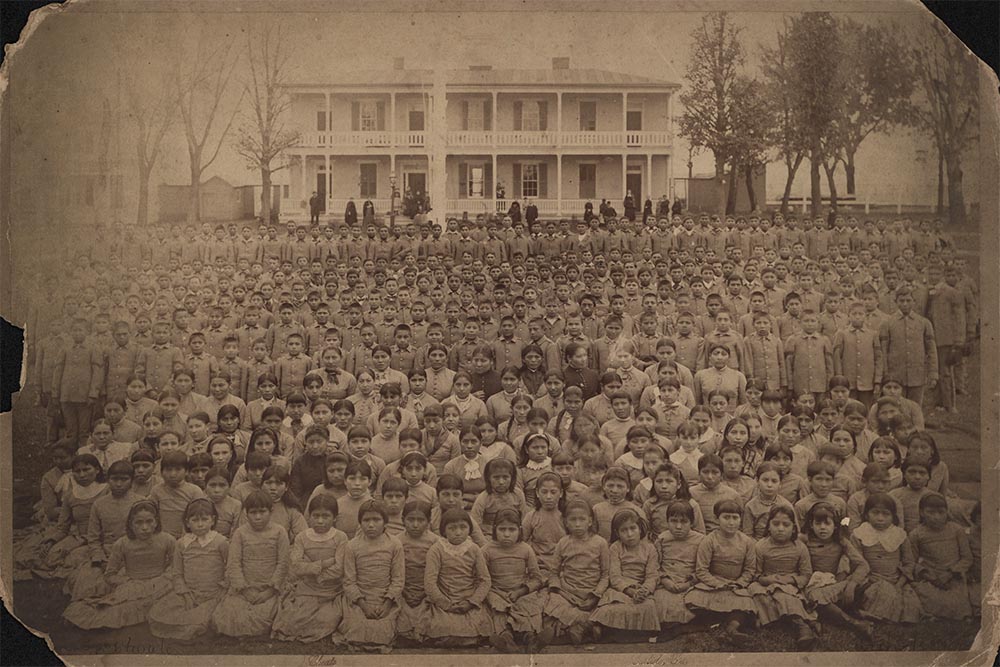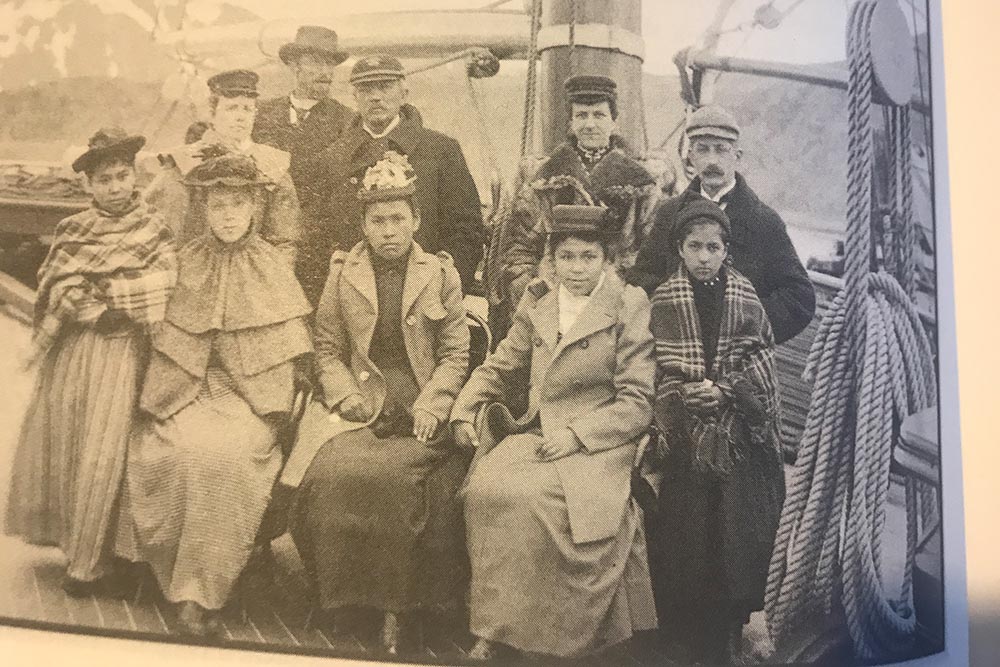
- Details
- By Jenna Kunze
CARLISLE, Penn. — The remains of 10 Native American and Alaska Native children who died more than 100 years ago while attending Carlisle Indian Industrial School in Pennsylvania are scheduled to be returned home to their communities in Alaska and South Dakota this week, according to a notice from the Department of the Army, which oversees the cemetery.
“These students died between 1880 and 1910 while attending the Carlisle Indian Industrial School,” the document reads. Nine of the children were from the Rosebud Sioux Tribe in South Dakota, and one was from Saint Paul Island in Alaska’s Bering Sea. “At the request of the closest living relative for each decedent, (The Office of Army Cemeteries) will disinter and facilitate the transport and reinterment of the remains in private cemeteries chosen by the families at government expense.”
Want more Native News? Get the free daily newsletter today.
The Carlisle Indian Industrial School was established from former U.S. army barracks by the Bureau of Indian Affairs in 1879, and served as the United States’ first boarding school for Indigenous children. Over the next 39 years, 7,800 Native children, forcibly removed from their homes across the United States, were made to attend Indian boarding schools throughout the country as part of the United States’ assimilationist agenda.
It was founded by Lt. Col. Richard Henry Pratt, whose common refrain from an 1892 speech he delivered was “kill the indian, save the man.” Carlisle was one of 357 Indigenous boarding schools that operated throughout the country.
The school was closed in 1918, when it was taken back under army control for returning soldiers from World War I. Its grounds are currently part of the U.S. Army War College.
 Five Alaska Native children sit aboard the Bear ship setting sail for the Jesse Lee Home for displaced children in Unalaska in 1895. On the far right is presumed to be Sophia Tetoff, age 8, and on the far left her sister Irene, age 12. (Photo/Image provided by the book “Family After All: Alaska's Jesse Lee Home,” page 32.)
Five Alaska Native children sit aboard the Bear ship setting sail for the Jesse Lee Home for displaced children in Unalaska in 1895. On the far right is presumed to be Sophia Tetoff, age 8, and on the far left her sister Irene, age 12. (Photo/Image provided by the book “Family After All: Alaska's Jesse Lee Home,” page 32.)
“For about the first 25 years or so, when students died, they were almost invariably buried here at the school,” said Jim Gerencser, an archivist at the Carlisle Indian School Digital Research Center, run by nearby Dickinson College. Records show that several of the deaths were due to tuberculosis or pneumonia, and that children’s remains weren’t returned to their home communities due to financial constraints, Gerencser said. “But after 1905, more of the students that had died while at the school were transported back to their home communities for burial.”
There are 180 marked gravesites for Indigneous students at the former school grounds, but Gerencser says there are a dozen more that are marked as “unknown” and are believed to belong to Native students as well. In 1927, the U.S. Army moved the gravesite from its original location to a street next to the barrack entrance.
The exhumations will be carried out by the Office of Army Cemeteries (OAC)—a department of the U.S. military that controls the nearly quarter of an acre property.
According to the Office of Army Cemeteries, the deceased children were: Sophia Tetoff “from the Alaskan Aleut”; and from the Rosebud Sioux: Lucy Take the Tail (Pretty Eagle); Rose Long Face (Little Hawk); Ernest Knocks Off (White Thunder); Dennis Strikes First (Blue Tomahawk); Maud Little Girl (Swift Bear); Friend Hollow Horn Bear; Warren Painter (Bear Paints Dirt); Alvan (Kills Seven Horses); Dora Her Pipe (Brave Bull).
Many of their deaths were announced in the local newspaper at the time, noting causes of death as “consummation,” or tuberculosis, or detailing circumstances of unknown sickness. In some cases, the student information card included their name and tribal affiliation. The cards also noted the dates of their arrival and, in swirly cursive, departure: “Cause of discharge: dead.”
Sophia Tetoff’s relative, Lauren Peters (Agdaagux Tribe) will travel to Pennsylvania on Friday, June 18, to exhume her great aunt. Peters, who grew up in California, is a PhD candidate in Native American studies at University of California, Davis, where she researches the human rights of the dead. She’s been waiting to exhume her aunt back to Saint Paul Island since 2018.
According to Peters, her two great aunts were taken to a welfare home about 300 miles south from their home community by missionaries in 1895 after being orphaned. Sophia’s sister died of sickness brought by gold rush settlers in 1990, and Sophia alone was sent 4,000 miles by boat and train to the Carlisle Indian Industrial School in Pennsylvania the following year.
“The Army is paying for the reinterment and travel costs for my son and I this summer,” Peters wrote in an op-ed for Native News Online. “She will be the first of many to return home to Alaska. I would guess that the costs today far outweigh the financial burden of two small girls on Saint Paul Island 126 years ago.”
According to Gerencser, “the facilities at Carlisle tended to be much better than they were elsewhere,” evidenced by a high-profile athletics program, the first X-ray machine in all of Carlisle, and a new school hospital that went up in 1881. He said there aren’t records of the physical and sexual abuse that many thousands of survivors faced throughout the boarding school-era. Away from their families and communities, Indigenous children were often punished for speaking their native languages, given less access to basic health care services, and sexually abused by their caretakers.
The impact of boarding schools, as detailed by the National Native American Healing Coalition, accounts for much of the intergenerational trauma experienced by Indigenous communities, including loss of identity, low self-esteem, no sense of safety, institutionaliz[ation], and difficulty forming healthy relationships.
Peters said that her great aunt’s student card paints a different picture. On the card, school administrators noted her height (4-foot-6) and weight (80 pounds) at 12 years old.
“Meaning she's probably malnourished, both on Saint Paul Island and going through the (boarding school) process,” Peters said.
Sophia Tetoff wasn’t the first child to be exhumed from Carlisle, and advocates like Peters say she won’t be the last.
In 2017, the U.S. military exhumed the first three Native children laid to rest at Carlisle to the Northern Arapaho Tribe after one tribal member fought for 10 years to bring former chiefs’ sons home.
According to Northern Arapaho Tribal Chairman, Jordan Dresser, tribal member Yufna Soldier Wolf fought for the return of three Arapaho children who are now re-buried on the reservation in Ethete, Wyo. That battle for exhumation is the plot of a documentary Dresser produced—set to air locally this weekend—“Home From School: The Children of Carlisle.”
In light of the recent discovery of a mass unmarked children’s grave in Canada at the site of a former residential school in Kamloops, British Columbia, Dresser said he’d be surprised if there weren't more buried children at Carlisle.
“The records are not as accurate as we want to believe,” he said. “You’ve got to assume the worst.”
Through the Northern Arapaho Tribe’s leadership, 11 children were exhumed between 2017 and 2019. In addition to the Northern Arapaho, those children belonged to the Piegan/Blackfeet Tribe, the Oglala Sioux Tribe, Oneida Nation, the Iowa Nation and the Modo Nation.
The current exhumation will begin on June 19 and is slated to take about a month, according to a report from the U.S. Office of Army Cemeteries. The cemetery will be closed during that time. Objections from family members and public comments can be mailed to Lt Col. Scott Tasler and Capt. Jason Netteler, the OAC project managers, or emailed.
Neither the Rosebud Sioux Tribe in South Dakota nor the Aleut Corporation responded to requests for comment.
“Repatriations are always really tough because you’re handling your ancestors,” Dresser said. “And you’re completing their life cycle. I believe the power of repatriations is that not only do we bring home our ancestors and also our sacred items, it opens up the door to healing.”
For descendants like Peters, in all the darkness brought on by stolen children, she said she marvels at how her great aunt is able to bring her and her sons back to the island of her ancestors.
“She is introducing me and my sons to the island where my mother was born. People are seeing her homecoming as the end of things being done to Alaska Natives and Unangax specifically,” she wrote. “Returning Sophia is creating an excitement on Saint Paul Island, and is giving hope to young people there that we can take back our culture, our language, and our stolen children.”
Lt. Col. Tasler and Capt. Nettelerat can be reached at 1 Memorial Ave., Arlington, Va. 22211 or by email at [email protected].
Tell Us What You Think
More Stories Like This
Native News Weekly (August 25, 2024): D.C. BriefsUS Presidents in Their Own Words Concerning American Indians
Ramos Introduces Three Bills Focused on Youth, Opioid Prevention, Foster Care & Tribal Student Data
Association on American Indian Affairs Opens Registration for 11th Annual Repatriation Conference
Operation Spirit Return Identifies Remains of Gila River, White Mountain Apache Man Missing Since 2020
Help us defend tribal sovereignty.
At Native News Online, our mission is rooted in telling the stories that strengthen sovereignty and uplift Indigenous voices — not just at year’s end, but every single day.
Because of your generosity last year, we were able to keep our reporters on the ground in tribal communities, at national gatherings and in the halls of Congress — covering the issues that matter most to Indian Country: sovereignty, culture, education, health and economic opportunity.
That support sustained us through a tough year in 2025. Now, as we look to the year ahead, we need your help right now to ensure warrior journalism remains strong — reporting that defends tribal sovereignty, amplifies Native truth, and holds power accountable.
 The stakes couldn't be higher. Your support keeps Native voices heard, Native stories told and Native sovereignty defended.
The stakes couldn't be higher. Your support keeps Native voices heard, Native stories told and Native sovereignty defended.
Stand with Warrior Journalism today.
Levi Rickert (Potawatomi), Editor & Publisher

